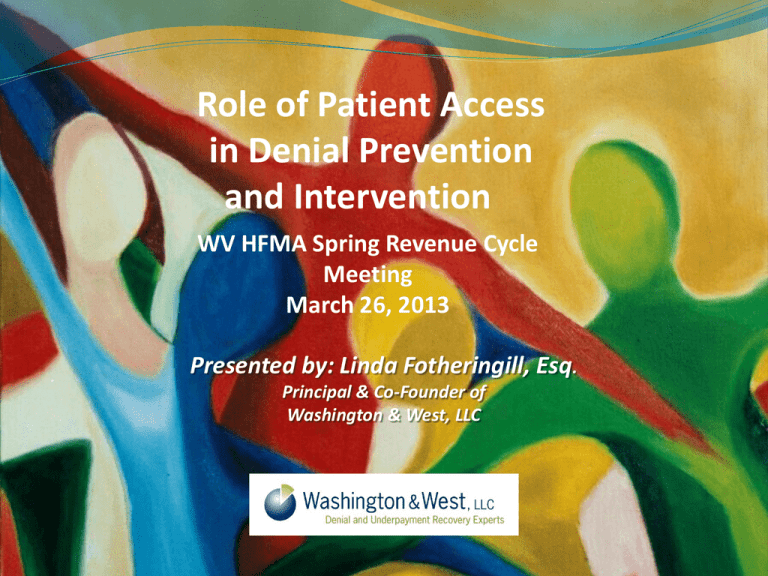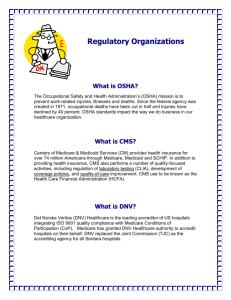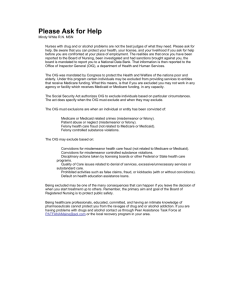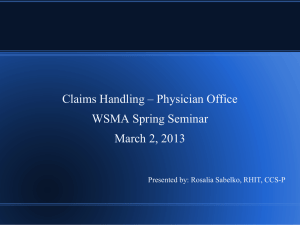
Role of Patient Access
in Denial Prevention
and Intervention
WV HFMA Spring Revenue Cycle
Meeting
March 26, 2013
Presented by: Linda Fotheringill, Esq.
Principal & Co-Founder of
Washington & West, LLC
Discussion Objectives:
1.
The Role of Patient Access in
prevention of Lack of Authorization denials
2.
Best Practice concepts for denial prevention
3.
The Role of Patient Access in prevention of Medicare Denials
4.
CMS Ruling No.: CMS-1455-R
Denials – Some Top Reasons
1.
2.
3.
4.
5.
6.
7.
8.
The claim was filed Late.
The Insurance Company Lost the Claim,
and then the Claim Expired
Lack of Preauthorization / Authorization
The Patient Didn’t acquire a Referral from
a Physician
You Provided Two Services in One Day
You Ran Out of Authorized Sessions
The Authorization Expired
The Patient Changed His or Her Insurance
Plan
9.
10.
11.
12.
13.
14.
15.
16.
The Patients' Out-of-network Benefits
Differ from In-network Benefits
The Service was Already Rendered
The Patient has an Out-of-State Insurance
Plan
The Patient Lost His or Her Insurance
Coverage
The Patient was Late to pay Their COBRA
Claim sent to the Wrong Managing
Company
The Provider doesn’t participate with the
Insurance Company
Services Were Rendered at the Wrong
Location
Lack of Authorization Denials
A 2009 study by the United States Government Accountability Office found
the following rate of lack of authorization denials in four states:
Ohio 2009
11 % across all insurers licensed in the state
Connecticut 2009
14 % across 21 managed care organizations licensed in the state
Maryland 2007
16 % across 41 insurers licensed in the state
California
24 % across six of the largest managed care organizations licensed in the state
Lack of Authorization – what does
this denial really mean?
Refined Code Examples
1.
Auth Obtained/Erroneously
denied
2.
Adm. Scheduled/Hosp. failed
to contact payer/obtain Auth
3.
Additional days requested/auth
approval for lower level of care
4.
Additional days requested/auth
refused
5.
Additional days not
requested/stay exceeded auth
6.
Auth not obtained but not
required
Accountable Dept/Entity
1.
Payer
2.
Patient Access, UM
3.
UM, Payer, Attending Physician
4.
UM, Payer, Attending Physician
5.
UM, Attending Physician
6.
Payer
Track accurate & meaningful data
Accurate & Meaningful Data Includes:
Refined denial/variance codes linked to accountable
Departments, individuals (i.e., Coders & Physicians), and
entity
Denial/variance codes linked to Contract provisions
and/or DRG, CPT, etc.
Detailed denial/audit database & feedback tool
Best Practice Denial Prevention
Maximize Opportunities with Appeal Team
Intervention/Appeal Track
Purpose:
To prevent retraction or obtain full
payment
Methodology:
To pursue all appeal levels until
payment received or appeal and
dispute resolution procedure
exhausted.
Prevention Track
Purpose:
To prevent future denials & ensure
compliance.
Methodology:
Provide appropriate feedback to Hospital
Department & staff
Track all denials by
Department/Physician
Educate & respond according to data
Monitor & Measure Response
If I Knew Then What I Know Now…
The information that is obtained during the admitting
process is crucial to prevent and fight denials
Almost all technical denials can be challenged
Facts
State and federal laws
Contract provisions
Registration and Admitting staff should have access to key
contract provisions and laws
Prevention of denials
Obtain critical facts
Insurance Verification Process
Just asking the right questions can prevent denials
Elicit information that is not routinely provided
Specific policy exclusions
Pre-existing conditions
Opportunity to correct potential benefit problems
Early registration
Lapses in coverage during admission/patient involvement
Documentation is the key to fight denials
Misverification of benefits/eligibility
There are state and federal laws on the following
denial management issues:
Authorization
Modification of
authorization,
delivery/newborn,
emergency services
Claims submission
Minimum time frames
Prompt payment
Definition of clean claim,
payment time frames,
interest penalty
Misverification of benefits
Internal/External Appeals
Subrogation
Retroactive denials/ Retractions
Notice prejudice
Lien laws
Workers compensation, Third
Party Liability
Pre-existing conditions
Emergency Services
State law definitions, EMTALA
Continuation of Benefits
ERISA
Coordination of benefits
Automatic newborn coverage
Experimental treatment
WVC §33-45-2
Minimum fair business standards contract provisions
required; processing and payment of health care services;
provider claims…
(6) Every insurer shall pay a clean claim if the insurer has previously authorized the health care
service or has advised the provider or enrollee in advance of the provision of health care
services that the health care services are medically necessary and a covered benefit, unless:
(A) The documentation for the claim provided by the person submitting the claim clearly fails to
support the claim as originally authorized; or
(B) The insurer's refusal is because:
(i) Another payor or party is responsible for the payment;
(ii) The provider has already been paid for the health care services identified on the claim;
(iii) The claim was submitted fraudulently or the authorization was based in whole or
material part on erroneous information provided to the insurer by the provider, enrollee,
or other person not related to the insurer;
(iv) The person receiving the health care services was not eligible to receive them on the
date of service and the insurer did not know, and with the exercise of reasonable care
could not have known, of the person's eligibility status;
(v) There is a dispute regarding the amount of charges submitted; or
(vi) The service provided was not a covered benefit and the insurer did not know, and with
the exercise of reasonable care could not have known, at the time of the certification that
the service was not covered.
WVC §33-45-2 (continued)
(2) Each insurer shall maintain a written or electronic record of
the date of receipt of a claim. The person submitting the claim
shall be entitled to inspect the record on request and to rely
on that record or on any other relevant evidence as proof of
the fact of receipt of the claim. If an insurer fails to maintain
an electronic or written record of the date a claim is received,
the claim shall be considered received three business days
after the claim was submitted based upon the written or
electronic record of the date of submittal by the person
submitting the claim.
WVC §33-25A-8d
Coverage of emergency services
(1) Every insurer shall provide coverage for emergency medical services,
including prehospital services, to the extent necessary to screen and to
stabilize an emergency medical condition. The insurer shall not require
prior authorization of the screening services if a prudent layperson acting
reasonably would have believed that an emergency medical condition
existed. Prior authorization of coverage shall not be required for
stabilization if an emergency medical condition exists. Payment of claims
for emergency services shall be based on the retrospective review of the
presenting history and symptoms of the covered person.
(E) "Medical screening examination" means an appropriate examination
within the capability of the hospital's emergency department, including
ancillary services routinely available to the emergency department, to
determine whether or not an emergency medical condition exists; and..
Authorization Process
Obtaining an authorization number for an admission is only half the
battle
What does the authorization number cover?
Tracking number
Our facility - transfers/direct admissions
Inpatient vs. outpatient
Number of days authorized
Documentation of name, phone & department of person providing
authorization
Insurer’s refusal to authorize admission
Participating facility/lower level of care
Where should the patient be admitted to?
What is the Must Have Contract Provision
for Lack of Authorization Denials?
“Insurer shall not deny or reduce payment for any
Medically Necessary Covered Services based on
Hospital’s failure to comply with any administrative
or notification requirements as set forth in this
Agreement and/or the Provider Manual insofar as
such services would have been authorized as
Medically Necessary if the notification had been
provided in the appropriate time.”
What about Medicare?
CMS 2011 Financial Report
Treasury
$536.7
Medicare & Medicaid
Social
Security
$784.2
payments represent:
53 cents of every $ spent
on nursing homes
49 cents of every $ received
by hospitals
31 cents of every $ spent
on physicians
Defense
$678.1
Other
$834.7
CMS
$767.4
Source: U.S. Treasury
$ in billions
Economic Reality
CMS 2012 Financial Report estimates complete exhaustion of Medicare Part A
trust funds by 2024
GAO’s simulations continue to illustrate that the long-term fiscal outlook is
unsustainable. … health care spending seen as the culprit. (80 million Americans
will become eligible for Social Security retirement benefits over the next two
decades—an average of more than 10,000 per day)
GAO reports $28.8 billion in improper payments in FY 2011
President’s Remarks to Joint Session of Congress:
“…we’ve estimated that most of this plan [PPACA] can be paid for by finding
savings within the existing health care system, a system that is currently full of
waste and abuse.”
CMS committed to “aggressive corrective actions”
United States Government Accountability Office (GAO)
http://www.gao.gov/assets/590/589681.pdf
Aggressive Corrective Action?
ZPIC
RAC
MAC
MIC
QIO
CERT
OIG
DOJ
FBI
The current landscape…..
“The OIG believes … healthcare providers have an ethical
and legal duty to ensure the integrity of their dealings
with these programs. This duty includes an obligation to
take measures, such as instituting a compliance program,
to detect and prevent fraudulent, abusive and wasteful
activities. It also encompasses the need to implement
specific procedures and mechanisms to examine and
resolve instances of non-compliance with program
requirements.”
Mandatory Compliance Program
under PPACA
1.PPACA Sec. 6102 applies to Medicare & Medicaid SNFs
8 core elements of mandatory program
2.PPACA Sec. 6401 applies to all Medicare & Medicaid
providers
DHHS required to promulgate “core elements” with
effective date (but no deadline yet)
Sept 2010 HHS proposed rule indicates similar core
elements to SNF & elements of U.S. Federal Sentencing
Guidelines
Does your current Compliance Program adequately
detect and prevent fraudulent, abusive and wasteful
activities?
Does your current Compliance Program adequately
implement specific procedures and mechanisms to
examine and resolve instances of non-compliance?
CMS RAC Appeals Update – June 2012
CLAIMS DENIALS OVERTURNED ON APPEAL
FY 2011
Number of claims with overpayment determinations
903,372
Number of claims where the provider appealed (any level)
56,620
Number of claims with appeal decisions in provider’s favor
24,548
Percentage of appealed claims with a decision in provider’s favor* 43.4%
Number of claims where provider did not appeal
846,752
Percentage of claims overturned on appeal for all denials
2.7%
* Often time Part B and DME claims are corrected through the appeals process, which means the reason for
the denial is upheld but the provider is allowed to correct the claim and rebill using the appropriate code(s).
Concerning Observations…
Continuing problems with clear documentation of
medical necessity.
Physicians are often not demonstrating a clear
understanding of Medicare’s criteria
EHRs are often inadequate for establishing compliance with
Medicare criteria
Lack of resources and/or culture to focus on improper
payment prevention
Healthcare Providers/Hospitals are “reactive” rather than
“proactive”
OIG Work plan - 2013
Hospitals—Inpatient and Outpatient Payments to Acute Care Hospitals
We will review Medicare payments to hospitals to determine compliance with
selected billing requirements. We will use the results of these reviews to
recommend recovery of overpayments and identify providers that
routinely submit improper claims.
Prior OIG audits, investigations, and inspections have identified areas at risk
for noncompliance with Medicare billing requirements. Using computer
matching and data mining techniques, we will select hospitals for focused
reviews of claims that may be at risk for overpayments. Using the same
techniques, we will identify hospitals that broadly rank as least risky across
compliance areas and those that broadly rank as most risky. We will then
review the hospitals’ policies and procedures to compare the compliance
practices of these two groups of hospitals. We will also survey or interview
hospitals’ leadership and compliance officers to provide contextual
information related to hospitals’ compliance programs.
The cost of failing to comply with
Medicare criteria?
Ultimately, will depend in part on whether deemed Fraud,
Abuse, or an Improper Payment.
Example: Civil penalty for False Claim liability is treble the
amount of damages plus $5,000 to $10,000 for each
claim!
How far back can the OIG go?
(b) A civil action under section 3730 may not be brought—
(1) more than 6 years after the date on which the violation of section
3729 is committed, or
(2) more than 3 years after the date when facts material to the right of
action are known or reasonably should have been known by the
official of the United States charged with responsibility to act in
the circumstances, but in no event more than 10 years after the date
on which the violation is committed, whichever occurs last.
Per Medicare Learning Network “…there is no
precise measure of health care fraud…”
Fraud?
Abuse?
Improper Payment?
Reasonable Minds can Differ?
What
Is
Medicare
Fraud?
Office of Inspector General: U.S. Department of Health and
Human Services
This Web page contains information about OIG's most-wanted health care fugitives.
In all, we are seeking more than 170 fugitives on charges related to health care fraud and abuse.
Click any of the photos below for more information about the fugitives or view captured fugitives
Etienne Allonce
DOB: 06-28-1965
Height: UNK
Weight: UKN
Tarek Wehbe
DOB: 11-29-1964
Height: 5’8”
Weight: 214 lbs
Carlos Benitez
DOB: 08-03-1961
Height: 5'9“
Weight: 180 lbs
Luis Benitez
DOB: 06-06-1966
Height: 5’11”
Weight: 195 lbs
http://oig.hhs.gov/fugitives/
What Is Medicare Abuse?
Practices that, either directly or indirectly, result in unnecessary costs to
the Medicare Program.
“Abuse appears quite similar to fraud except that it is not possible to
establish that abusive acts were committed knowingly, willfully, and
intentionally.”
Examples of Medicare abuse may include:
Misusing codes on a claim,
Charging excessively for services or supplies, and
Billing for services that were not medically necessary or services that
do not meet professionally recognized standards.
Both fraud and abuse can expose providers to criminal and civil liability.
Question…..
Can billing Medicare for a knee replacement when the
documentation does not support medical necessity per
CMS criteria be considered fraud or abuse?
What about when the denial is not appealed?
If so, Providers are exposed to civil and criminal liability.
News Release, February 11, 2013
Departments of Justice and Health and Human Services
announce record-breaking recoveries resulting from joint
efforts to combat health care fraud
Government Teams Recovered $4.2 Billion in FY 2012
Attorney General Eric Holder and Health and Human Services
(HHS) Secretary Kathleen Sebelius report that for every dollar
spent on health care-related fraud and abuse investigations in
the last three years, the government recovered $7.90.
This is the highest three-year average return on investment
in the 16-year history of the Health Care Fraud and Abuse
(HCFAC) Program.
OIG EDUCATIONAL STATEMENTNot just after the big fish…
False Claims Act cases are in the news and many involve large
companies, such as drug and device manufacturers or
pharmaceutical companies.
“But there also are many cases involving smaller entities and
individuals. For example, a recent FCA case involved a
cardiologist who allegedly submitted claims to the Federal
health care programs for services that were not supported by
patient medical records and did not meet the billing criteria.
Additionally, the physician allegedly billed separately for
services that the government had already paid for as part of a
bundled payment for a group of services. To resolve these
allegations the doctor paid $435,000 and entered into a 5-year
Integrity Agreement.”
OIG – 2013 Work Plan
Recovery Audit Contractors—Identification and
Recoupment of Improper and Potentially Fraudulent
Payments and CMS’s Oversight and Response
“We will determine the extent that Recovery Audit
Contractors (RAC) identified improper payments,
identified vulnerabilities, and made potential fraud
referrals in 2010 and 2011. We will also review the
activities that CMS performed to resolve RAC-identified
vulnerabilities, address potential fraud referrals, and
evaluate RAC performance in 2010 and 2011. (Affordable
Care Act, § 6411.)”
Zone Program Integrity Contractors (ZPICs)
ZPICs identify
target areas
based on:
ZPIC
Zone
1
California, Hawaii, Nevada, American Samoa, Guam,
and the Mariana Islands
AdvanceMed
2
Washington, Oregon, Idaho, Utah, Arizona, Wyoming,
Montana, N. Dakota, S. Dakota, Nebraska, Kansas,
Iowa, Missouri, Alaska
Cahaba
3
Minnesota, Wisconsin, Illinois, Indiana, Michigan, Ohio,
Kentucky
Health Integrity
4
Colorado, New Mexico, Texas, Oklahoma
AdvanceMed
5
Arkansas, Louisiana, Mississippi, Tennessee, Alabama,
Georgia, N. Carolina, S. Carolina, Virginia, W. Virginia
Under Protest
6
Pennsylvania, New York, Delaware, Maryland, D.C.,
New Jersey, Massachusetts, New Hampshire, Vermont,
Maine, Rhode Island, Connecticut
Safeguard Services
7
Florida, Puerto Rico, Virgin Islands
Safeguard Services
•Investigations
•OIG and law
enforcement
instructions
•Congressional
mandates
•Data Mining
or “Predictive
Modeling”
States in Zone
MAC “Provider Tracking System” (PTS)
MACs must have a PTS
Will identify all providers & track all contacts to correct
“problems” such as medical necessity issues & repeated
“billing abusers”
Information coordinated with ZPIC
Quarterly reassessments to see if behavior has changed
Information shared with Administrative Law Judge when
cases appealed
Administrative Law Judge Comment
in Unfavorable ALJ Decision:
“The Provider was unquestionably aware of the CMS
regulations, manuals and rulings, CMS bulletins, past
unfavorable CMS contractor actions and the lack of
substantiating medical records. See 42 CFR Section
411.406(e) (knowledge presumed from experience and
constructive notice of CMS publications).”
Alabama Medical Review of LCD A-03-03
(Replacement of Lower Extremity Joint)
May 2005 – Error Rate 88.78% ($1,585,067 charges denied of
107 Claims reviewed for 49 Providers)
Majority of denials because “documentation in the medical
record did not provide sufficient justification for the services
rendered”
QIO did targeted education to improve compliance
December 2005 – Error Rate increased to 91.25% ($1,034,375
charges denied of 100 Claims reviewed for 42 Providers)
Sample Issue:
DRG 470:
Joint Replacement or Reattachment of Lower
Extremity
Medicare Newsletter – June 6, 2011
DRG 470: Joint Replacement or Reattachment of Lower Extremity
In order to meet the criteria for a total knee replacement
procedure, all of the following must be documented:
Documentation of level of pain and worsening of pain
Pain that is increased with activity
Pain that is increased with weight bearing
Pain that interferes with activities of daily living
Pain with passive range of motion
Limited range of motion
Crepitus
Joint effusion / swelling
Medicare Newsletter – June 6, 2011
DRG 470: Joint Replacement or Reattachment of Lower Extremity (con’t.)
An x-ray must be obtained and must have at least two of the following
findings:
Subchondral cysts
Subchondral sclerosis
Periarticular osteophytes
Joint subluxation
Joint space narrowing
Documentation must indicate continued symptoms after a trail of
medication (i.e. NSAIDs) or the contraindication of medication due to the
patient’s inability to tolerate.
Documentation of physical therapy or external joint support 12 weeks or
greater.
Billing for Part B Services After
Part A Services are Denied
Old Rule
See the Medicare Benefit Policy Manual, Chapter 6,
Hospital Services Covered Under Part B, Section 10.
Interim Rule
http://www.ofr.gov/(S(2yzxk55mcriryqcephbfo5gx))/OFRUpload/
OFRData/2013-06159_PI.pdf
Proposed Rule
https://www.federalregister.gov/articles/2013/03/18/2013-
06163/medicare-program-part-b-inpatient-billing-in-hospitals
Old Rule
Hospitals could only receive reimbursement for “a
limited set of largely ancillary inpatient services under
Part B.” *
These claims are considered “new claims subject to
timely filing guidelines.”
*Described in detail in the Medicare Benefit Policy Manual, Chapter 6, Hospital
Services Covered Under Part B, Section 10.
Interim Rule
CMS Ruling No.: CMS-1455-R
Addresses CMS policy on Part B billing following the
denial of a Part A inpatient hospital claim on the basis
that the inpatient admission was determined not
reasonable and necessary
Effective March 13, 2013
Permits submission of a Part B claim for payment for
payable services had the beneficiary been treated as an
outpatient with no timely filing restrictions
Exception: those services that require outpatient status, i.e.
ED visits, office visits, observation services
Proposed Final Rule
Published in the Federal Register on 3/18/13
Permits submission of a Part B claim for payment for
payable services had the beneficiary been treated as an
outpatient with a timely filing restriction
Part B claim must be billed within one year of the DOS!
ALJs/MACs in the future will not be permitted to issue a
partially favorable decision and allow payment for Part B
services
Recommendations of W&W
Interim Rule
Continue to Appeal claims that
you have billed appropriately.
Proposed Final Rule
Review proposed rule to
determine how it will affect
your facility specifically
Timely filing requirement
Submit comments to CMS no
later than 5 pm on 5/17/13!
In Summary….
1.
Emphasis on Denial Prevention
2.
Education, Education, Education!
3.
Follow Medicare, Medicaid & Managed Care/Commercial Rules
4.
Collect accurate and meaningful data
5.
6.
Best Practice Appeal for all wrongfully denied cases
Contract Review for fair & appropriate terms
7.
Ability & willingness to act on your data –
Feedback & Enforcement to ensure that Physicians & Departments
know & follow payer criteria & documentation requirements!!!
Questions?
Linda Fotheringill, Esq.
Washington & West, LLC
One Olympic Place
Suite 500
Baltimore, Maryland 21204
1- 800 -704 – 5574
www.washingtonwest.com
l.fotheringill@washingtonwest.com
Please Take Note!
Washington & West, LLC is not a law firm. The information conveyed in this
presentation is for general educational purposes and is not legal advice. The
application and impact of laws can vary widely, based on the specific facts
involved. Given the constantly changing nature of state and federal laws, there
may be omissions or inaccuracies in the information you receive during this
program. Accordingly, any information is provided with the understanding that
the presenter is not rendering legal, accounting, or other professional advice
and services. As such, any information obtained in this presentation should not
be used as a substitute for consultation with legal counsel or other professional
advisors specifically retained for that purpose. While Washington & West, LLC
has made every attempt to ensure that the information contained in these
materials is generally useful for educational purposes, Washington & West, LLC,
RAC University and its agents & employees are not responsible for any errors or
omissions or for the results obtained through the use of any information herein.
Copyright 2013 by Washington & West, LLC. All rights
reserved.








